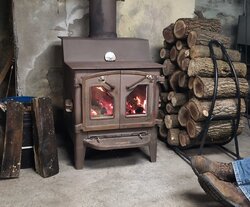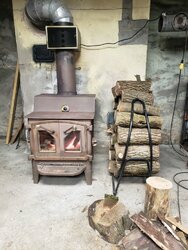Hello, i have been doing some research on this forum and am really glad to see there are people out there soo interested in this, i collect and restore old chainsaws so i can defintely relate so some degree and appreciate most anything vintage and of good build quality, i am by no means a chevy over ford kind of guy, i find appreciation and beauty in everything, anyway i recently bought a fisher grandma bear version 3 brass and glass i guess its referred to as, I am in love with this stove! I bought it to heat my shop so i could work as i just refused to continue purchasing oil for my furnace, i am soo glad I made this investment and honestly have been finding myself sitting in front of this beautiful stove rather than being productive in my shop for which it was originally intended for.
So to get to the point i have a 8x8 terracotta chimney, approx 25' straight up, its in great shape and pulls a good draft, I have the stove hooked up with 8" flu pipe as intended with draft control and a vogelzang heat reclaimer, approx 20 inches above the stove, i understand these are a tabu subject however i will say it is currently doimg a great job and i prefer this deshn to the magic heater design because it is much less restrictive and still works well, the stove does have a baffle plate and seems to work great, however i am always looking for ways to maximize efficiency with anything and would really like some insight on what i can do to maximize burn time/efficiency with this wonderful new stove that i now own as far as creating a secondary burn and maximizing the baffle inside, i am tradesman and can make whatever i need in my shop any help would be greatly appreciated and look forward to talking and maybe making new friends with other stove owners, thanks!
So to get to the point i have a 8x8 terracotta chimney, approx 25' straight up, its in great shape and pulls a good draft, I have the stove hooked up with 8" flu pipe as intended with draft control and a vogelzang heat reclaimer, approx 20 inches above the stove, i understand these are a tabu subject however i will say it is currently doimg a great job and i prefer this deshn to the magic heater design because it is much less restrictive and still works well, the stove does have a baffle plate and seems to work great, however i am always looking for ways to maximize efficiency with anything and would really like some insight on what i can do to maximize burn time/efficiency with this wonderful new stove that i now own as far as creating a secondary burn and maximizing the baffle inside, i am tradesman and can make whatever i need in my shop any help would be greatly appreciated and look forward to talking and maybe making new friends with other stove owners, thanks!




